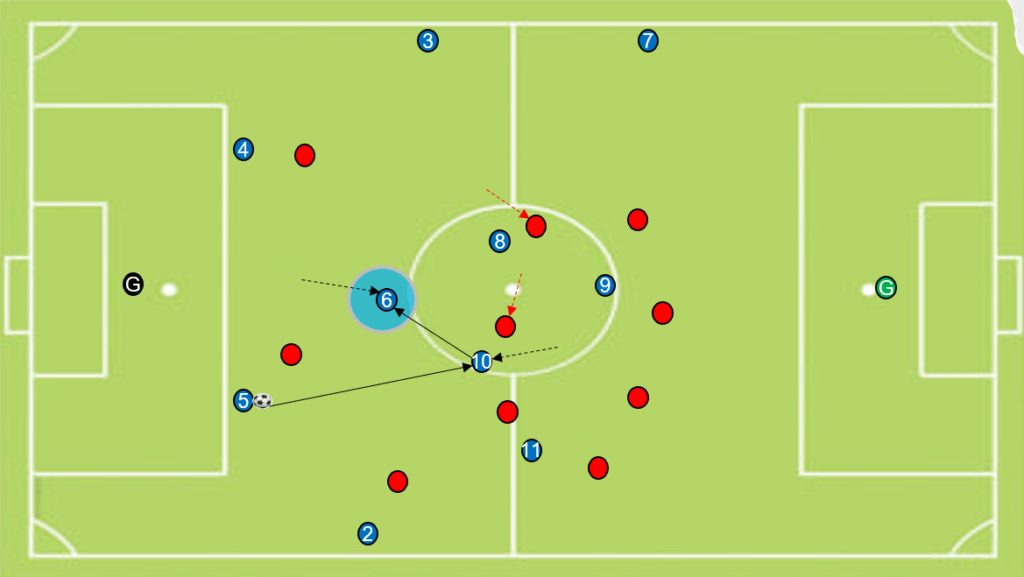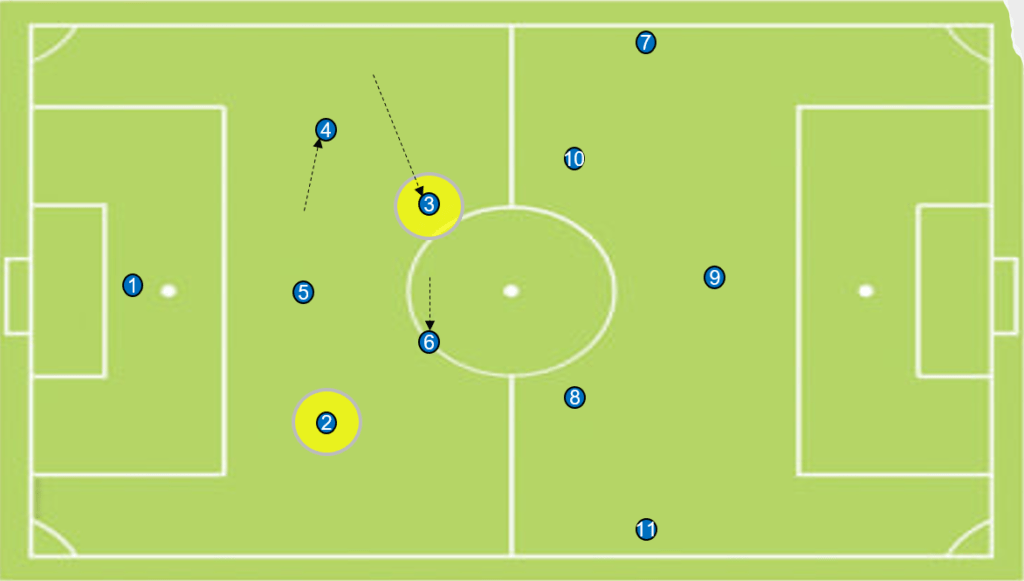Numerical overloads in football (or superiorities) occur when one team has more players in a particular area of the field than the opposing team. This tactic can be used by a football manager to create a numerical advantage in a specific area of the pitch, which can help a team create goal scoring opportunities, control possession of the ball, or attract the opponents in order to create another advantage (1v1) in a different area.
Many of the most successful teams in the Premier League and Champions League frequently utilize numerical overloads in football to gain positional superiority over the opposition players, allowing them to dominate matches through intelligent movement and structured football tactics.
For example, a team may use a numerical overload in midfield by pushing defenders up or dropping back forwards into that area. This can help the team control possession, offer more passing options, and allow the central midfielder to dictate play with greater ease.
A classic example of this is the way Bayern Munich, under Pep Guardiola, structured its build-up play, often using a full-back to invert into midfield to create an overload, enabling more fluid transitions from defense to attack. Similarly, Jurgen Klopp’s teams, whether at Liverpool or Borussia Dortmund, have been known to use dynamic positional rotations to create numerical advantages in key zones, ensuring that the attacking team can always progress the ball efficiently.
Here is an example of a training drill that can be used to help players understand and execute midfield overloads. Such drills are an essential part of modern soccer coaching, as they help players recognize when and where to create superiorities on the pitch. This is a classic example of implementing numerical overloads in football, a fundamental aspect of total football philosophy, which emphasizes fluid movement and intelligent positioning to break down defensive structures.
Similarly, a team may use numerical superiority in a wide area by pushing more players out wide. A wide overload can force the opposition defenders to shift across, potentially creating space for a winger or an advancing full-back to exploit.
This can allow them to deliver a cross into the box for an attacking player to convert into a goal. Many top teams in world football use this approach to stretch the opposition, making it harder for them to remain compact defensively.
Numerical overloads in football can be particularly effective when used in conjunction with other tactics, such as pressing or counter-attacking. However, they can also be risky if not executed properly, as they can leave gaps in other areas of the field that the opposing team can exploit.
A well-drilled soccer team must be prepared to transition quickly in case possession is lost. The best teams, particularly those competing in the Champions League, ensure that their tactical setup accounts for both offensive superiority and defensive stability.
Soccer coaching at the highest level emphasizes this balance, as seen in the structured but fluid approaches of modern managers like Roberto De Zerbi and Marcelo Bielsa. Therefore, numerical overloads in football require careful planning, coordination, and positional awareness among all players on the pitch, from the central midfielders to the full-backs, to be truly effective.
What kinds of overloads occur in football?
Depending on the field situation and the team’s tactical approach, teams can produce one or more of the 4 different overloads in modern football. The Positional Play methodology approach relies heavily on the overloads. The following are the 4 typical overloads:
- Numerical overloads: The term “numerical overload” refers to situations where one team has more players on a specific area of the pitch than the other team. For example, a team might overload the midfield by moving more players forward from the defensive line or the wings by moving more players out wide, for instance. In football, creating a back 3 against a team that presses with two forwards throughout the buildup is another traditional numerical overload.

- Positional overloads: This is when a team has players in certain positions on the field who can create an advantage by causing challenges to the defenders. For example, a playing positioned in the half space will put the full back to think which one to defend, the wide winger or the inside attacking midfielder?
- Qualitative overloads: This is when a team creates an overload by utilising the specific skills and attributes of certain players. For example, a team may overload the wings by using fast and skilful wingers who can beat their opponents in one-on-one situations.
- Socio-affective overloads: This is when a team has an advantage due to the player’s good relationship and understanding on and off the pitch.
It’s important to remember that different kind of numerical overloads in football can be employed in conjunction with one another and that the suitable overload will be determined by the game situation and the playing style of the team.
It is very important to keep in mind that football is a very fluid game and any kind of advantage or overload creating it can be for a limited time. It’s on the team’s and player’s ability to recognize it quickly and take advantage of it.

82 Passing, Positional Possession, Games, Patterns, and Attacking Practices Direct from Bayer Leverkusen Training Sessions
- The basic principles of Dutch Academy coaching
- Use different build up shapes (4-2-4, 3-2-5, 2-3-5) against different opponents
- Dominate possession and midfield area with precision, patience, and control
- Draw in the press and break the lines of the opposition
- Create overloads around the ball to progress play forward
- Positional play with movement, rotations, and interchanges
- Utilise innovative and dynamic wing back play in attack
- Implement incisive attacking play with attacking overloads in the final third
How to create numerical overloads in football?
There are several ways to create numerical overloads in football, and the method used will depend on the team’s playing style, formation, and the specific situation on the field. Here are some ways that teams can create overloads:
- Overlap: This is when a full-back runs past the winger to create a 2v1 situation against the opposing team’s full-back.
- Underlap: This is when a midfielder runs past the forward to create a 2v1 situation against the opposing team’s center-back.
- Third-man runs: This is when a player makes a run to receive a pass from a teammate who has already received the ball. This can create a temporary numerical advantage in that area of the field.

- Rotations: This is when players change positions on the field during the game. This can confuse the opposing team’s defense and create space for players to exploit. A very used one is to rotate the FB, WG and midfielder of the strong side of the ball. Another one that Pep Guardiola and Mikel Arteta use a lot is the inverted full backs. By pushing one or two full backs inside the team will have two defensive midfielders that will help for a shorter build up from the back.

- Overloading a flank: This is when a team pushes more players out wide on one side of the field, creating a numerical advantage against the opposing team’s full-back and winger.
Conclusion
It’s important to note that creating numerical overloads in football requires communication and coordination of movements among players. Players need to be able to anticipate their teammates’ actions. Additionally, creating overloads can be risky, as it can leave gaps in other areas of the field, so teams need to be aware of their defensive responsibilities as well.

